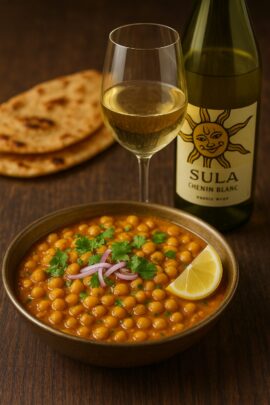1. Introduction
Dish Name & Cultural Context:
Ghughani is a beloved Eastern Indian dish, especially popular in Bihar, Jharkhand, Odisha, and Bengal. Traditionally made during festive occasions and street food fairs, it’s a comforting yet vibrant preparation of yellow or white peas (matar), cooked with aromatic spices. It holds a special place in regional breakfasts and evening snacks and is often served with puffed rice or parathas.
Key Ingredients & Preparation Style:
The core ingredients include dried white/yellow peas, mustard oil, garlic, ginger, green chilies, onions, tomatoes, and a spice blend typically including cumin, coriander, turmeric, and garam masala. The peas are soaked overnight, then simmered and sautéed with spices to develop a rich, earthy and slightly tangy flavor.
Flavor & Texture Profile:
- Flavors: Earthy, spicy, tangy (from tomatoes or lemon), sometimes smoky if mustard oil is used.
- Texture: Soft yet chewy legumes, velvety gravy, with occasional crunch from onions or garnishes.
Science Behind Spice & Wine Interactions:
- Acidity in wine helps balance the dish’s earthy legumes and tangy tomatoes.
- Low Tannins are preferred to avoid clashing with chili heat and mustard oil bitterness.
- Slight Sweetness in off-dry wines can soothe the burn of chili and round out spice levels.
- Alcohol Level: Moderate alcohol works best; high alcohol can intensify heat.
- Spice Compounds: Capsaicin (from chilies) and allyl isothiocyanate (from mustard oil) heighten perceived bitterness, requiring wines with fruit-forward or semi-sweet profiles to counterbalance.
2. Ideal Wine Pairings: Science & Art of Selection
White Wines
Sula Chenin Blanc (Nashik, India)
Why it Works: This Indian white has a mild sweetness, fresh acidity, and tropical fruit notes that tame the mustard oil’s sharpness and elevate the earthy legumes. The off-dry style also counters chili heat beautifully.
Regions/Producers to Try:
- Sula Vineyards (Nashik, India)
- Vallonné Vineyards (Nashik) — their Viognier is another aromatic option with floral and apricot notes.
Grüner Veltliner (Austria)
Why it Works: Known for white pepper notes and lime-like acidity, it harmonizes with Ghughani’s spice structure and refreshes the palate.
Regions/Producers to Try:
- Domäne Wachau
- Weingut Bründlmayer
Red Wines
Pinot Noir (Oregon or Burgundy)
Why it Works: Light-bodied with low tannins and red berry acidity, Pinot Noir adds elegance without overwhelming the delicate legume texture or amplifying spice.
Regions/Producers to Try:
- Domaine Drouhin Oregon
- Louis Jadot (Bourgogne)
Sangiovese (Chianti, Italy)
Why it Works: High acidity, rustic red fruit, and subtle earthy undertones align well with Ghughani’s tomato-rich gravy. Tannins are manageable, especially if lightly chilled.
Regions/Producers to Try:
- Castello di Volpaia
- Felsina Berardenga
3. Unexpected Pairings: Lesser-Known but Great Choices
Sparkling Rosé (e.g., Brut Rosé from India or Spain)
Why it Works: The bubbles lift the rich gravy, and the berry notes offer contrast. Its chill and freshness cut through the mustard oil’s assertiveness.
Gewürztraminer (Alsace or Himachal)
Why it Works: Aromatic, with lychee and spice notes that mirror and soften the dish’s heat. A hidden gem with Indian legumes.
4. Wines to Avoid & Common Mistakes
Which to Avoid:
- Heavily oaked Chardonnays: Clash with mustard oil and overwhelm the peas.
- Cabernet Sauvignon/Malbec: High tannins + chili = bitterness and heat amplification.
- Dry Sherry: Too nutty and saline; doesn’t align with earthy-tangy notes.
| Mismatched Pairing | Why It Doesn’t Work | Better Alternative |
|---|---|---|
| Oaked Chardonnay | Butter and oak flavors fight mustard oil | Off-dry Chenin Blanc |
| Cabernet Sauvignon | Tannins exaggerate chili and dry the palate | Light Pinot Noir |
| Dry Sherry | Overly saline and oxidized | Sparkling Rosé |
5. Final Thoughts & Expert Tips
Key Takeaways:
- Ghughani pairs best with low-tannin reds and off-dry or aromatic whites.
- Favor Indian wines with fresh acidity and fruit-forward character.
- Avoid high alcohol or tannins that can intensify spice.
Fun Fact:
The mustard oil used in Ghughani has compounds similar to wasabi and horseradish, which activate different spice receptors than chili peppers — meaning your wine must fight a battle on two spice fronts!
Personal Note:
Pairing Ghughani with chilled Sula Chenin Blanc during a humid Kolkata evening was a delightful surprise — the wine’s fruity softness tamed the spice while honoring the dish’s warmth and depth.
6. Recipe & Wine-Friendly Adjustments
Ingredients:
- 1 cup dried yellow/white peas (soaked overnight)
- 2 tbsp mustard oil
- 1 medium onion (chopped)
- 1 tsp garlic-ginger paste
- 1 green chili (optional)
- 1 tomato (chopped)
- 1/2 tsp turmeric, 1 tsp cumin, 1 tsp coriander
- Salt to taste, lemon juice, fresh coriander
Preparation:
- Pressure cook soaked peas until soft but intact.
- Heat mustard oil till smoking. Add cumin, then onion, garlic-ginger paste, chili.
- Add tomatoes and spices. Cook into a thick masala.
- Add cooked peas and simmer for 10 mins.
- Finish with lemon juice and chopped coriander.
Wine-Friendly Modifications:
- Use milder chili or omit if sensitive to spice.
- Replace mustard oil with neutral oil and mustard seeds for a softer version.
Serving Suggestions:
- Serve warm in a shallow bowl with puffed rice or toasted flatbread.
- Garnish with fresh lime and red onion slivers for texture.
- Use chilled wine glasses to offset the heat of the dish.

